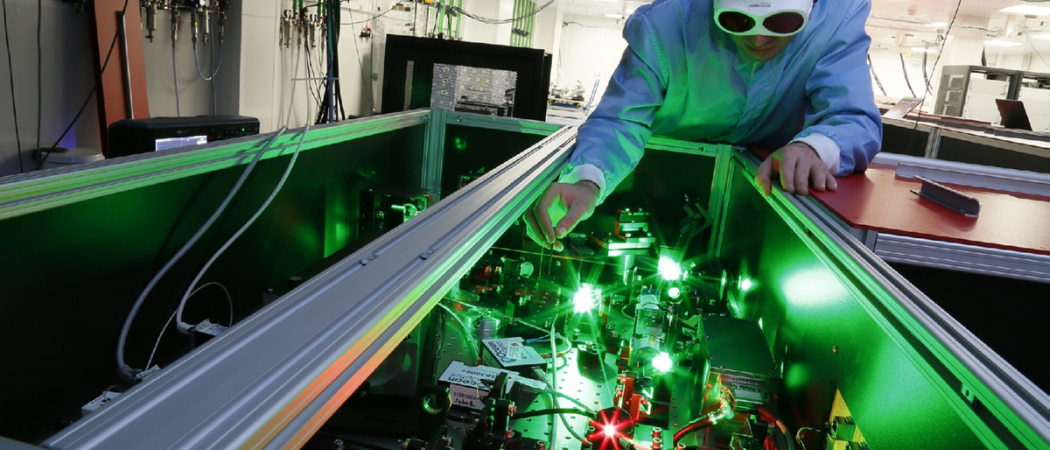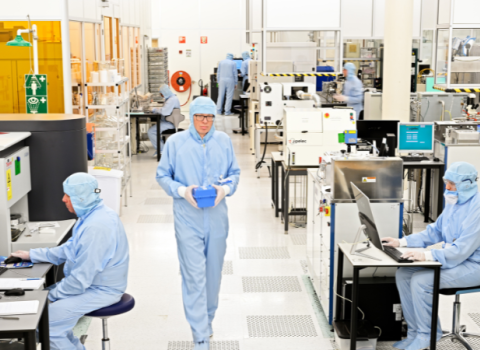Outgoing research minister is optimistic that ELI-NP will join the European laser research consortium by 2023, but laments frequent changes at the top of the Romanian research system

Researcher tests laser at ELI-NP. Photo: Thales.
Romania is on track to join the laser European Research Infrastructure Consortium (ERIC), outgoing research minister Ciprian Teleman announced after he resigned last week.
The Extreme Light Infrastructure consortium (ELI-ERIC) was initially slated to pull together three new laser research facilities in the Czech Republic, Hungary and Romania, but was approved by the European Commission earlier this year based on an application that excluded Romania from the group of founding members.
The three labs were the first large research infrastructures in the EU to be built with structural funds. The goal was to give researchers from around the world access to state-of-the-art lasers for experiments that could spur discovery and innovation in radioactive waste management, medical imaging, gamma radiography and cancer therapies.
Teleman said Romania’s participation in ERIC is in the process of being “unlocked” with the Romanian government having “resumed dialogue” with the other governments involved. He said Romania has moved up to negotiations to “a very advanced stage” and hopes ELI-NP can join ERIC by March 2023, the final deadline given by the European Commission to complete the project.
Romania was excluded from the group of founding members of ERIC after the Bucharest-based ELI-Nuclear Physics (ELI-NP) facility got caught up a legal dispute with EuroGammaS, a European consortium of research institutes and companies contracted to build and install a €67 million gamma source in Romania.
Romania also had disagreements with the other two countries over how ELI-ERIC should function, seeking privileged access for local researchers who had little chance of winning access bids against colleagues in countries with richer research systems.
The disputes are not fully settled, but the dismissal of ELI-NP director Nicolae Zamfir last year, and more meaningful government involvement, gave diplomatic talks a boost. Zamfir was replaced by Călin Ur, former head of the GAMMA experiment at the Italian Institute of Nuclear Physics (INFN) in Padova. The INFN was one of the main partners in the EuroGammaS consortium.
“We have all the reasons to believe that we have made up for the lost time and we will deliver this project on time,” said Teleman.
In June, the Czech and Hungarian labs started operations under the common legal umbrella of the newly established ERIC. “The lab’s sites can now operate legally together, as one organisation,” said Allen Weeks, director general of ELI-ERIC. “This is an important step since the transition to operations is already happening, and the interest from scientists is intense.”
Political drama
Teleman, who resigned last week after the governing coalition collapsed, laments frequent changes at the top of the Romanian research system, which he believes stifle plans for long-term reform.
Since 2016, the country has moved the research ministry in and out of the education portfolio, with half a dozen ministers taking on the role of research chief. In the latest coalition collapse, prime minister Florin Cîțu also fired two state secretaries at the research ministry, which, Teleman said, will further stifle long-term projects.
Teleman also announced the government has just unlocked enough money for Romania to start paying debts to the European Space Agency (ESA). The country’s voting rights in the ESA were suspended after it failed to pay contributions since 2017. The government now has the money to pay half of the €124 million debt, with the remaining half to be paid at a later stage.





 A unique international forum for public research organisations and companies to connect their external engagement with strategic interests around their R&D system.
A unique international forum for public research organisations and companies to connect their external engagement with strategic interests around their R&D system.